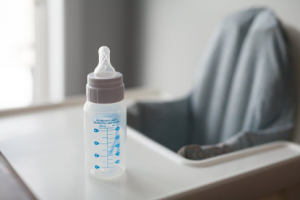Transiting from maternity leave to return to work can be stressful for moms, especially when it comes to the logistics of pumping breast milk at work.
Getting your breastfed baby comfortable with bottle-feeding
One of the most stressful concerns for a working mother returning to work is whether your baby will take to being fed by his caretaker. This is often a key concern for mums who exclusively latch their babies, and babies who have refused bottles or hardly drink from milk bottles.

If mum needs to be away from your baby, let a trusted caregiver feed your child with expressed breastmilk in a bottle.
To counter this, after your milk supply has been established and baby does not have nipple confusion, it is a good idea for other caretakers (for example, baby’s father and other family members) to start bottle-feeding (here are things to prepare for bottle feeding for reference!). There are babies who may not take to bottle-feeding (have you heard of these bottle feeding myths?) and it is best to find solutions or alternatives before heading back to work.
Communicate your breastfeeding needs to colleagues
Before you return to work, it is a good idea to inform your Human Resource colleague or team mates about your need to express breastmilk during working hours. This would give them a heads-up that you will need to take some time during the day to pump, and most people would generally be understanding of a new mother’s needs.

To ease your transition back to work, have a casual chat with your boss and/or colleagues about the need for you to express breastmilk during working hours.
You may want to fill your colleagues in on the duration, or even general logistics of your pumping sessions so that they have some understanding before you commence on your pump sessions at work.
Scheduling pump sessions during the work day
Before you return to work, it is important to be aware of how long you can go without a pump session, while maintaining sufficient breast milk for your baby. With this knowledge, you will be able to estimate how often you will need to express breast milk when you return to work. However, having said that, you may have to pump within a limited time at your work place and may need to lengthen the interval between each pumping session.
Examine a regular workday and first find pockets of time that you could possibly fit in a pump session. For example, you can choose to express milk before you leave for work, during lunchtime and after work. If that already works for you, great, if not, you can make adjustments depending on the nature of your job.
Prepare yourself mentally for the pumping sessions at work
It is not uncommon for breastfeeding mothers to experience a dip in breast milk due to the stress of transitioning back to work and maintaining your breast milk supply. (Here are other reasons why breast milk may dip as well)

In such situations, breastfeeding mums may try out breast milk inducing foods (here are 5 of them!) or even have a few favorite photos of baby on hand to help you stimulate letdown during your pump sessions.
Wearing breastfeeding-friendly clothing that enables pump sessions
We often have to maintain a professional image at work and the usual nursing wear or breastfeeding friendly clothing may or may not work in this setting. To counter this, you can get the following types of clothing that may be both work and pumping appropriate, the best part is that you may already have these in your wardrobe:
- Button down tops or dresses
- Zip front tops or dresses
- Flared tops
- Wraps / Tie front tops or dresses

Wear work-appropriate outfits that allow you to pump milk easily without fuss.
Tips for working mum who needs to pump
- Breast pump
Some breast pumps need to run with power from an electrical socket while others can operate just as well on battery. You may want to pick a portable, powerful breast pump that allows you to pump even on the go as this will come in useful if you need to schedule pumping sessions in the car or while travelling for work.
Some breast pumps allow you to be hands-free while you are pumping and you will be able to still work while having your breast milk expressed. If you can, keep a set of breast pump accessories at work to eliminate the situation where you forget to pack them to bring to the office.
Tip:Did you know that if you leave your pump parts in an airtight container in the fridge, you will be able to use the equipment to pump throughout the day without having to wash them? This is because breast milk can stay fresh in the fridge for up to 4 days, hence a few hours interval will not cause the breast milk on your equipment to turn bad or affect the quality of the milk collected
- Milk bags
Pick milk bags that are BPA-free and lock securely. Once you are done pumping into a milk bottle attached to your pump, you can very carefully transfer your breast milk into the bags and lay them flat in the freezer or refrigerator in your office pantry. Freezing milk bags flat allow you to easily store more milk within a limited amount of space.
Tip:Keep spare milk bags in the office for times when you might have forgotten your milk bottle, or even your breast pump. At the very least, you will be able to hand express some of your breast milk.
- Cooler bags / Ice packs
Transporting your precious milk does not have to be stressful. You can either transport them by placing them in between ice packs alternately within an insulated bag, or, buy one of the freezer bags that comes with build-in ice packs. Both types of bags are available at baby care stores in Singapore.
With these tips on hand, we hope that you are now more well prepared to transition back to work while continuing your breastfeeding journey.
Breastfeeding working mums, how did you manage transit back to work while providing breast milk for your babies? Share some tips in the comments!

